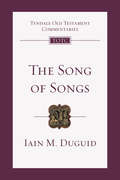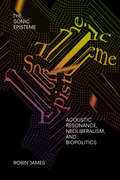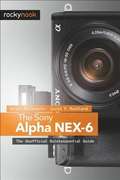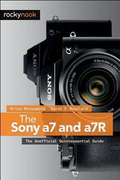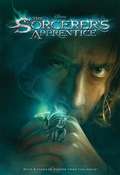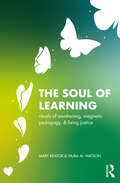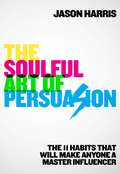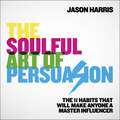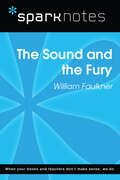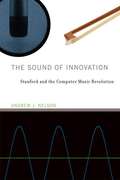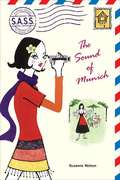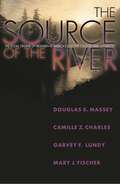- Table View
- List View
The Someday Daughter
by Ellen O'CloverPerfect for fans of Rachel Lynn Solomon, Mary H. K. Choi, and Alex Light! From the critically acclaimed author of Seven Percent of Ro Devereux comes another heartrending and nuanced novel about family, love, and the cost of ambition.“A compelling, beautifully drawn exploration into complicated family and personal relationships and the frailty and fortitude of a girl simply trying to succeed, love, and thrive. I’m proud to live in a book world where Ellen O’Clover is writing contemporary young adult fiction. The Someday Daughter is a forever treasure.” —Laura Taylor Namey, New York Times bestselling author of A Cuban Girl’s Guide to Tea and Tomorrow Audrey St. Vrain has grown up in the shadow of someone who doesn’t actually exist. Before she was born, her mother, Camilla St. Vrain, wrote the bestselling book Letters to My Someday Daughter, a guide to self-love that advises treating yourself like you would your own hypothetical future daughter. The book made Audrey’s mother a household name, and she built an empire around it.While the world considers Audrey lucky to have Camilla for a mother, the truth is that Audrey knows a different side of being the someday daughter. Shipped off to boarding school when she was eleven, she feels more like a promotional tool than a member of Camilla’s family. Audrey is determined to create her own identity aside from being Camilla’s daughter, and she’s looking forward to a prestigious summer premed program with her boyfriend before heading to college and finally breaking free from her mother’s world. But when Camilla asks Audrey to go on tour with her to promote the book’s anniversary, Audrey can’t help but think that this is the last, best chance to figure out how they fit into each other’s lives—not as the someday daughter and someday mother but as themselves, just as they are. What Audrey doesn’t know is that spending the summer with Camilla and her tour staff—including the disarmingly honest, distressingly cute video intern, Silas—will upset everything she’s so carefully planned for her life.
The Song of Songs: A Biography (Lives of Great Religious Books #46)
by Ilana PardesAn essential history of the greatest love poem ever writtenThe Song of Songs has been embraced for centuries as the ultimate song of love. But the kind of love readers have found in this ancient poem is strikingly varied. Ilana Pardes invites us to explore the dramatic shift from readings of the Song as a poem on divine love to celebrations of its exuberant account of human love. With a refreshingly nuanced approach, she reveals how allegorical and literal interpretations are inextricably intertwined in the Song's tumultuous life. The body in all its aspects—pleasure and pain, even erotic fervor—is key to many allegorical commentaries. And although the literal, sensual Song thrives in modernity, allegory has not disappeared. New modes of allegory have emerged in modern settings, from the literary and the scholarly to the communal.Offering rare insights into the story of this remarkable poem, Pardes traces a diverse line of passionate readers. She looks at Jewish and Christian interpreters of late antiquity who were engaged in disputes over the Song's allegorical meaning, at medieval Hebrew poets who introduced it into the opulent world of courtly banquets, and at kabbalists who used it as a springboard to the celestial spheres. She shows how feminist critics have marveled at the Song's egalitarian representation of courtship, and how it became a song of America for Walt Whitman, Herman Melville, and Toni Morrison. Throughout these explorations of the Song's reception, Pardes highlights the unparalleled beauty of its audacious language of love.
The Song of Songs: An Introduction and Commentary (Tyndale Old Testament Commentaries #Volume 19)
by Iain M. DuguidThis Old Testament book, ?the best of songs?, has fascinated and perplexed interpreters for centuries. We hear the passionate melody of romantic love, and are confronted by erotic imagery but whose love is described? Is it a couple?s love for each other, God?s love for his people, or a poem that speaks to love in all its dimensions? Iain Duguid?s commentary explains how the Song is designed to show us an idealized picture of married love, in the context of a fallen and broken world. It also convicts us of how far short of this perfection we fall, both as humans and as lovers, and drives us repeatedly into the arms of our true heavenly husband, Jesus Christ. The Tyndale Old Testament Commentaries have long been a trusted resource for Bible study. Written by some of the world's most distinguished evangelical scholars, these twenty-eight volumes offer clear, reliable and relevant explanations of every book in the Old Testament, aiming to get at the true meaning of the Bible and to make its message plain to readers today.
The Songwriter's Idea Book
by Sheila DavisIn her first two books, Sheila Davis classified the major song forms and enduring principles that have been honored for decades by America's foremost songwriters. Those books have become required reading in music courses from NYU to UCLA. In The Songwriters Idea Book, Davis goes one step further, giving you 40 strategies for designing distinctive songs. You'll break new ground in your own songwriting by learning about the inherent relationship between language style, personality type and the brain. You'll go, step by step, through the creative process as you activate, incubate, separate and discriminate. You'll learn to use the whole-brain techniques of imaging, brainstorming and clustering. You'll expand your skilled use of figurative language with paragrams, metonyms, synecdoche and antonomasia. You'll be challenged to design metaphors, form symbols, make puns and coin words. And, you'll learn how to prevent writer's block, increase your productivity and maintain your creative flow. Over 100 successful student lyrics from pop, country, cabaret, and theater serve as role-models to illustrate the "whole-brain" songwriting process.
The Sonic Episteme: Acoustic Resonance, Neoliberalism, and Biopolitics
by Robin JamesIn The Sonic Episteme Robin James examines how twenty-first-century conceptions of sound as acoustic resonance shape notions of the social world, personhood, and materiality in ways that support white supremacist capitalist patriarchy. Drawing on fields ranging from philosophy and sound studies to black feminist studies and musicology, James shows how what she calls the sonic episteme—a set of sound-based rules that qualitatively structure social practices in much the same way that neoliberalism uses statistics—employs a politics of exception to maintain hegemonic neoliberal and biopolitical projects. Where James sees the normcore averageness of Taylor Swift and Spandau Ballet as contributing to the sonic episteme's marginalization of nonnormative conceptions of gender, race, and personhood, the black feminist political ontologies she identifies in Beyoncé's and Rihanna's music challenge such marginalization. In using sound to theorize political ontology, subjectivity, and power, James argues for the further articulation of sonic practices that avoid contributing to the systemic relations of domination that biopolitical neoliberalism creates and polices.
The Sony Alpha NEX-7
by Brian Matsumoto Carol F. RoullardThe Sony Alpha NEX-7: The Unofficial Quintessential Guide provides a wealth of experience-based information and insights for owners of this exciting new camera. Authors Carol F. Roullard and Brian Matsumoto team up to help the new user navigate past the confusion factor that often comes with complex and powerful camera equipment. This book explores the features and capabilities of the camera in a way that far surpasses the user's manual. It guides you through the camera features with step-by-step setting adjustments and detailed how, when, and why explanations for each option. Every button, dial, switch, and menu configuration setting is explored in a friendly manner, with suggestions and tips for setup according to various shooting styles. The informative text is illustrated with screenshots and example images throughout, making it easy to follow along. The authors cover everything from the basic features of the camera to numerous advanced photographic applications. The first section of the book teaches the new user to start taking pictures immediately by using the camera's Intelligent Automatic mode. The second section covers how to begin taking more control by switching to the semi-automatic modes. Finally, you'll learn to take full manual control of the camera, allowing you to break some "rules" and capture images that are a unique reflection of your creative personality. Carol and Brian go beyond just the camera itself and share how third-party software and optional accessories can improve on the camera's standard commands. You'll even learn how the electronic viewfinder, the fixed mirror, and Sony's novel shutter design improve the camera's utility for critical scientific photography (i.e., photomicrography and photography through the telescope).The Sony Alpha NEX-7: The Unofficial Quintessential Guide will allow you to really take control of your camera, to push the envelope, and to have fun.
The Sony SLT-A77
by Brian Matsumoto Carol F. RoullardThis book provides enthusiastic photographers with a wealth of information about the unique features of the Sony SLT-A77, an interchangeable-lens camera with an electronic viewfinder and a fixed, translucent mirror. The A77 differs from the current crop of DSLRs in its ability to use a phase detection focusing system throughout the entire picture-taking process, for both still photographs and videos. This provides an immediacy and responsiveness when using burst shots and creating HD videos that is unavailable in any other camera. In this guide, authors Carol Roullard and Brian Matsumoto teach you how to obtain exceptional photographs and videos as they cover everything from the basics of using the camera's automatic modes, to the more advanced aperture-priority, shutter-priority, program, and manual exposure modes. You'll also learn how best to take advantage of features such as the built-in dynamic range adjustment, sweep panoramic, GPS, colorization modes, facial detection and recognition, multiple shot exposures, and HD video. The authors provide you with an opportunity to improve your skills even further by discussing how third-party software and accessories can improve Sony's standard commands. You'll also learn about how the electronic viewfinder, fixed mirror, and Sony's novel shutter design improve the camera's utility for scientific photography through the microscope and telescope. Additional topics include:Advantages of the electronic viewfinder for previewing your photographs Using the accessory Sony shoe-mount flash Advantages of using the JPEG file format Advantage of having a fixed mirror and electronic first curtain shutter Settings for using the camera on a microscope and telescope Using the older Minolta Maxxum lenses
The Sony a7 and a7R
by Brian Matsumoto Carol F. RoullardThis book is a guide to using the Sony a7 and a7R, the first full frame, autofocus system cameras. At half the weight of a full frame DSLR, they are easy to carry for photographers on the go. The less-expensive a7 has a 24-megapixel sensor for shooting rapidly changing scenes; the a7R has a 36-megapixel sensor designed for ultimate image sharpness. Both use advanced image-processing algorithms and can use any manufacturer's lens when matched with the appropriate adapter. The electronic viewfinder gives the photographer an accurate preview of the image, ensuring the capture of technically excellent photographs by preventing mistakes in color temperature, depth of field, and exposure. All features of the a7 and a7R are covered, including automatic stitching to create panoramas, and multi-shot noise reduction that allows the use of extremely high ISOs. This book guides the photographer in using both the camera's automated features and manual controls to take photographs that are a unique reflection of his or her creative personality.
The Sorcerer's Apprentice
by James Ponti Disney Storybook Art TeamThe junior novel is a 144-page retelling of the blockbuster film, The Sorcerer's Apprentice. A young physics student learns that he's the inheritor of the powers of Merlin--and suddenly finds himself in the middle of a war between two of Merlin's protégés.
The Soul of Discernment
by Elizabeth LiebertThe Soul of Discernment provides concrete steps for groups of people who work together and need to make important decisions: church sessions, nonprofit hiring committees, etc. Liebert calls this process the Social Discernment Cycle, a process for seeking God's call in a particular situation. "It is called 'social' because it deals primarily with human communities in their social-structural, rather than interpersonal aspects," Liebert explains. "It is a cycle because one completed round of discernment prepares for the next. The Social Discernment Cycle is particularly apt for any discernment that involves a structure, system, or institution. " This book helps groups work through this cycle to answer the question, "How is God leading us, individually or together, to act in this particular moment in our organization?"
The Soul of Learning: rituals of awakening, magnetic pedagogy, and living justice
by Mary Keator Vajra WatsonThe Soul of Learning is a groundbreaking book that bridges together cultural work, contemplative practices, and ancient scriptures. Inside each chapter, readers are challenged and inspired to come face-to-face with themselves as they encounter teachers in all forms—from spiritual sages to critical theorists, from prophets to poets, from hip-hop rappers to reggae artists. This book is multifaceted and multidisciplinary. It models the essence of education by offering multiple entry points into holistic learning: somatic, aesthetic, emotional, intellectual, ethical, relational, and spiritual. The Soul of Learning embodies a pedagogical disruption in pursuit of personal sovereignty. What process must we go through to reimagine ourselves in relation to each other and the world around us? This book offers a semblance of an answer. As a way to bring the sacred into schooling, Keator and Watson courageously connect spirituality, activism, and education through curated readings, guided activities, and intentional exercises. It’s a ready-to-go syllabus and hands-on workbook all in one! Altogether this book is revelatory and provides innovative ways to teach and learn, lead and live. The Soul of Learning documents a transformative journey, through the interiority of our being into a revolutionary call for collective belonging.
The Soul of a University: Why Excellence is not Enough
by Chris BrinkWhat is the role of a university in society? In this innovative book, Chris Brink offers the timely reminder that it should have social purpose, as well as achieve academic excellence. The current obsession with rankings and league tables has perpetuated inequality and is preventing social mobility. This book shows how universities can – and should - respond to societal challenges and promote positive social change.
The Soul's Sincere Desire
by Glenn Clark“THERE are some modern-day prophets who hold that truth, like light, is impersonal, infinite, universal, and eternal, and who rejoice that they are selfless channels by means of which its radiance may reach humankind. The most exalted of these covet no personal fame for themselves, deriving their reward rather from seeing the dawn they love steadily expand and increase into high noon and flood all the plain with light.From such Olympian light-gatherers as these I have lit my torch. The only acknowledgment I can conceive of that seems at all worthy of such pure natures is the continued spreading of their light, that it may reach a larger circle and bring joy to a greater number.Only a few of these light-givers came to me in the form of books. More have come to me as friends bearing gifts; still more have come as eager questioners; their very needs have brought into the light new conceptions, which, had not their hunger drawn them forth, might otherwise never have been revealed. But deserving of gratitude above all the rest, a gratitude that can never be repaid in words, is that silent band of men and women of many churches and many creeds, whose prayers have been a mighty force in bringing into manifestation Truth more exalted than the voice of him who utters it, and Light greater than the lamp that sends it forth.”-Introduction
The Soulful Art of Persuasion: The 11 Habits That Will Make Anyone A Master Influencer
by Jason HarrisThe Soulful Art of Persuasion is a revolutionary guide to becoming a master influencer in an age of distrust through the cultivation of character-building habits that are essential to both personal growth and sustained business success. This isn't a book full of tips and life-hacks. Instead, The Soulful Art of Persuasion will develop the habits that others want to be influenced by. This book is based on a radical idea: Persuasion isn't about facts and argument. It's all about personal character.Jason Harris, CEO of the powerhouse creative agency Mekanism, argues that genuine persuasion in the twenty-first century is about developing character rather than relying on the easy tactics of flattery, manipulation, and short-term gains. It is about engaging rather than insisting; it is about developing empathy and communicating your values. Based on his experience in and out of the boardroom, and drawing on the latest in-depth research on trust, influence, and habit formation, Harris shows that being persuasive in a culture plagued by deception means rejecting the ethos of the quick and embracing the commitment of putting your truest self forward and playing the long game. Through instructive and entertaining stories, Harris lays out the 11 habits that will guide readers to become authentically persuasive, including Earning respect through collaboration Becoming the person others want to be around Practicing generosity through gestures big and smallPersuasion today is about personal excellence, sharing the stage, and respecting other people's motivations. In The Soulful Art of Persuasion, Jason Harris shows us the way.
The Soulful Art of Persuasion: The 11 Habits That Will Make Anyone A Master Influencer
by Jason HarrisThe Soulful Art of Persuasion is a revolutionary guide to becoming a master influencer in an age of distrust through the cultivation of character-building habits that are essential to both personal growth and sustained business success. This isn't a book full of tips and life-hacks. Instead, The Soulful Art of Persuasion will develop the habits that others want to be influenced by. This book is based on a radical idea: Persuasion isn't about facts and argument. It's all about personal character.Jason Harris, CEO of the powerhouse creative agency Mekanism, argues that genuine persuasion in the twenty-first century is about developing character rather than relying on the easy tactics of flattery, manipulation, and short-term gains. It is about engaging rather than insisting; it is about developing empathy and communicating your values. Based on his experience in and out of the boardroom, and drawing on the latest in-depth research on trust, influence, and habit formation, Harris shows that being persuasive in a culture plagued by deception means rejecting the ethos of the quick and embracing the commitment of putting your truest self forward and playing the long game. Through instructive and entertaining stories, Harris lays out the 11 habits that will guide readers to become authentically persuasive, including Earning respect through collaboration Becoming the person others want to be around Practicing generosity through gestures big and smallPersuasion today is about personal excellence, sharing the stage, and respecting other people's motivations. In The Soulful Art of Persuasion, Jason Harris shows us the way.(P) 2019 Penguin Random House Audio
The Sound and the Fury (MAXNotes Literature Guides)
by Boria SaxREA's MAXnotes for William Faulkner's The Sound and the Fury MAXnotes offer a fresh look at masterpieces of literature, presented in a lively and interesting fashion. Written by literary experts who currently teach the subject, MAXnotes will enhance your understanding and enjoyment of the work. MAXnotes are designed to stimulate independent thought about the literary work by raising various issues and thought-provoking ideas and questions. MAXnotes cover the essentials of what one should know about each work, including an overall summary, character lists, an explanation and discussion of the plot, the work's historical context, illustrations to convey the mood of the work, and a biography of the author. Each section of the work is individually summarized and analyzed, and has study questions and answers.
The Sound and the Fury (SparkNotes Literature Guide Series)
by SparkNotesThe Sound and the Fury (SparkNotes Literature Guide) by William Faulkner Making the reading experience fun! Created by Harvard students for students everywhere, SparkNotes is a new breed of study guide: smarter, better, faster. Geared to what today's students need to know, SparkNotes provides: *Chapter-by-chapter analysis *Explanations of key themes, motifs, and symbols *A review quiz and essay topicsLively and accessible, these guides are perfect for late-night studying and writing papers
The Sound of Innovation
by Andrew J. NelsonIn the 1960s, a team of Stanford musicians, engineers, computer scientists, and psychologists used computing in an entirely novel way: to produce and manipulate sound and create the sonic basis of new musical compositions. This group of interdisciplinary researchers at the nascent Center for Computer Research in Music and Acoustics (CCRMA, pronounced "karma") helped to develop computer music as an academic field, invent the technologies that underlie it, and usher in the age of digital music. In The Sound of Innovation, Andrew Nelson chronicles the history of CCRMA, tracing its origins in Stanford's Artificial Intelligence Laboratory through its present-day influence on Silicon Valley and digital music groups worldwide. Nelson emphasizes CCRMA's interdisciplinarity, which stimulates creativity at the intersections of fields; its commitment to open sharing and users; and its pioneering commercial engagement. He shows that Stanford's outsized influence on the emergence of digital music came from the intertwining of these three modes, which brought together diverse supporters with different aims around a field of shared interest. Nelson thus challenges long-standing assumptions about the divisions between art and science, between the humanities and technology, and between academic research and commercial applications, showing how the story of a small group of musicians reveals substantial insights about innovation. Nelson draws on extensive archival research and dozens of interviews with digital music pioneers; the book's website provides access to original historic documents and other material.
The Sound of Innovation: Stanford and the Computer Music Revolution (Inside Technology)
by Andrew J. NelsonHow a team of musicians, engineers, computer scientists, and psychologists developed computer music as an academic field and ushered in the era of digital music.In the 1960s, a team of Stanford musicians, engineers, computer scientists, and psychologists used computing in an entirely novel way: to produce and manipulate sound and create the sonic basis of new musical compositions. This group of interdisciplinary researchers at the nascent Center for Computer Research in Music and Acoustics (CCRMA, pronounced “karma”) helped to develop computer music as an academic field, invent the technologies that underlie it, and usher in the age of digital music. In The Sound of Innovation, Andrew Nelson chronicles the history of CCRMA, tracing its origins in Stanford's Artificial Intelligence Laboratory through its present-day influence on Silicon Valley and digital music groups worldwide. Nelson emphasizes CCRMA's interdisciplinarity, which stimulates creativity at the intersections of fields; its commitment to open sharing and users; and its pioneering commercial engagement. He shows that Stanford's outsized influence on the emergence of digital music came from the intertwining of these three modes, which brought together diverse supporters with different aims around a field of shared interest. Nelson thus challenges long-standing assumptions about the divisions between art and science, between the humanities and technology, and between academic research and commercial applications, showing how the story of a small group of musicians reveals substantial insights about innovation. Nelson draws on extensive archival research and dozens of interviews with digital music pioneers; the book's website provides access to original historic documents and other material.
The Sound of Munich (Students Across the Seven Seas)
by Suzanne NelsonSiena Bernstein attends school in Munich for three months, where she perfects her German language skills, flirts with her attractive resident advisor, and attempts to find the man who helped her father's family escape East Berlin in 1962.
The Soundtrack Composer's Ultimate Guide to FL Studio: Learn to score films and games, compose orchestral music, and launch your music career
by Joshua Au-YeungCreate and compose production-quality music with the power of FL Studio 20 along with MuseScore and WwiseKey FeaturesDevelop widely applicable music composition techniques and create full orchestral scoresLeverage the power of FL Studio to create your own production-level soundtracksUse cutting-edge tools to fuel your creative ideas and launch your composer careerBook DescriptionFL Studio is a cutting-edge software music production environment and a powerful and easy-to-use tool for composing music. In this comprehensive guide, you'll discover how to use FL Studio's tools and techniques to design exciting soundtracks for your films, TV shows, video games, and much more. You'll start by understanding the business of composing, learning how to communicate, score, market your services, land gigs, and deliver music projects for clients like a professional. Next, you'll set up your studio environment, navigate key tools, such as the channel rack, piano roll, playlist, mixer, and browser, and export songs. The book then advances to show you how to compose orchestral music using MIDI (musical instrument digital interface) programming, with a dedicated section to string instruments. You'll create sheet music using MuseScore for live musicians to play your compositions. Later, you'll learn about the art of Foley for recording realistic sound effects, create adaptive music that changes throughout video games, and design music to trigger specific emotions, for example, eerie music to terrify your listener. Finally, you'll work on a sample project that will help you prepare for your composing career. By the end of this book, you'll be able to create professional soundtrack scores for your films and video games.What you will learnCompose production-ready music for films and video gamesPlan and deliver a soundtrack music score for clients like a professionalApply practical music theory using themes, leitmotifs, scales, and modesCompose orchestral music with MIDI programmingDesign music for specific emotionsCreate sheet music with MuseScore, score music for films with Fruity Video Player, and make diegetic musicDesign interactive music by leveraging horizontal resequencing and vertical remixingWho this book is forThis book is for musicians and programmers who want to take their music composing skills to a professional level. Film directors and game designers who want to get involved in scoring music for their own productions will also find this book useful. All you need is a computer and FL Studio to get started.
The Source Book of Short Text: The Comprehension Toolkit Language and Lessons for Active Literacy
by Stephanie Harvey and Anne GoudvisToolkit includes ready-to-teach lessons for reading comprehension. It also helps you to design your own comprehension strategy lessons to develop independent readers and learners across any content or curriculum. The teaching and learning in The Comprehension Toolkit series centers on comprehension-strategy lesson books organized around foundational comprehension strategies.
The Source for Reading Fluency
by Nancy B. SwigertThis book is designed to help students who were inaccurate readers.
The Source of My Strength: Relying on the Life-Changing Power of Jesus to Heal Our Wounded Hearts
by Charles F. StanleyAre you lonely? Do you feel restless and frustrated? Is anxiety eating away your joy or insecurity threatening your peace of mind? These problems may be symptoms of emotional wounds that need the healing touch of Jesus.The Source of My Strength is a moving and personal look at the power of Christ to comfort those who hurt and to free those who are oppressed. Sharing his own journey through emotional pain, Dr. Charles Stanley offers biblical principles that help you:overcome pain, insecurity, frustration, loneliness, and alienationunderstand how emotional burdens constrict and confine your choices in lifeconfront painful memories of the pastfind healing and hope in the promises of GodIf you long to live fully and freely every day, this practical guide can help you discover your liberty in Christ.No matter who we are today, we are poor?or lacking?in some way. We are captives to the memories of the past and the limited expectations we have for our futures. And unless we are willing to deal with the painful experiences that life brings our way, the pain becomes a burden and wound of the heart. Today is a great day to ask the Lord Jesus to take off your heart the heavy load you are carrying. ?Charles Stanley
The Source of the River: The Social Origins of Freshmen at America's Selective Colleges and Universities (The William G. Bowen Series #43)
by Douglas S. Massey Garvey Lundy Mary J. Fischer Camille Z. CharlesAfrican Americans and Latinos earn lower grades and drop out of college more often than whites or Asians. Yet thirty years after deliberate minority recruitment efforts began, we still don't know why. In The Shape of the River, William Bowen and Derek Bok documented the benefits of affirmative action for minority students, their communities, and the nation at large. But they also found that too many failed to achieve academic success. In The Source of the River, Douglas Massey and his colleagues investigate the roots of minority underperformance in selective colleges and universities. They explain how such factors as neighborhood, family, peer group, and early schooling influence the academic performance of students from differing racial and ethnic origins and differing social classes. Drawing on a major new source of data--the National Longitudinal Survey of Freshmen--the authors undertake a comprehensive analysis of the diverse pathways by which whites, African Americans, Latinos, and Asians enter American higher education. Theirs is the first study to document the different characteristics that students bring to campus and to trace out the influence of these differences on later academic performance. They show that black and Latino students do not enter college disadvantaged by a lack of self-esteem. In fact, overconfidence is more common than low self-confidence among some minority students. Despite this, minority students are adversely affected by racist stereotypes of intellectual inferiority. Although academic preparation is the strongest predictor of college performance, shortfalls in academic preparation are themselves largely a matter of socioeconomic disadvantage and racial segregation. Presenting important new findings, The Source of the River documents the ongoing power of race to shape the life chances of America's young people, even among the most talented and able.


